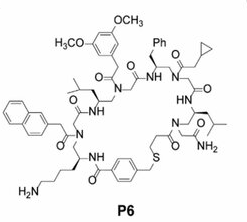| Cas No.: | |
| Chemical Name: | γ-AA peptide P6 |
| SMILES: | CC(C)C[C@H]1CN(CC(N)=O)C(=O)CCSCC2C=CC(=CC=2)C(=O)N[C@H](CN(CC(=O)N[C@H](CN(CC(=O)N[C@@H](CC2C=CC=CC=2)CN(CC(=O)N1)C(=O)CC1CC1)C(=O)CC1C=C(C=C(C=1)OC)OC)CC(C)C)C(=O)CC1=CC2=CC=CC=C2C=C1)CCCCN |
| Formula: | C73H98N10O11S |
| M.Wt: | 1323.68 |
| Purity: | >98% |
| Sotrage: | 2 years -20°C Powder, 2 weeks 4°C in DMSO, 6 months -80°C in DMSO |
| Publication: | Bo Huang, et al. Activation of E6AP/UBE3A-Mediated Protein Ubiquitination and Degradation Pathways by a Cyclic γ-AA Peptide. J Med Chem. 2022 Feb 10;65(3):2497-2506. |
| Description: | γ-AA peptide P6 (Cyclic γ-AA P6) is a potent activator of E6 associated protein (E6AP). γ-AA peptide P6 can stimulate the self-ubiquitination of E6AP and E6AP-catalyzed substrate ubiquitination in reconstituted reactions in vitro. γ-AA peptide P6 can also enhance the ubiquitination of E6AP substrates in the cell and accelerate their degradation by the proteasome. |
| References: | Bo Huang, et al. Activation of E6AP/UBE3A-Mediated Protein Ubiquitination and Degradation Pathways by a Cyclic γ-AA Peptide. J Med Chem. 2022 Feb 10;65(3):2497-2506. |

 To enhance service speed and avoid tariff delays, we've opened a US warehouse. All US orders ship directly from our US facility.
To enhance service speed and avoid tariff delays, we've opened a US warehouse. All US orders ship directly from our US facility.




















